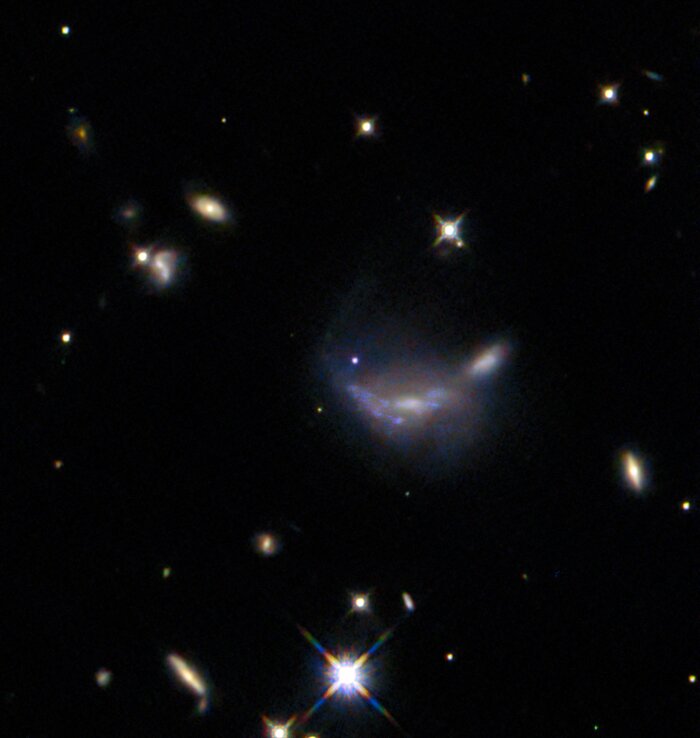One in a hundred
The subject of this NASA/ESA Hubble Space Telescope Picture of the Week is a supernova-hosting galaxy located about 600 million light-years away in the constellation Gemini. This picture was taken roughly two months after a supernova named SN 2022aajn was discovered in this galaxy. The supernova is visible as a blue dot at the centre of the image, brightening the hazy body of the galaxy.
Other than the announcement of its discovery in November 2022, SN 2022aajn has never been the subject of published research. Why, then, would Hubble observe this supernova? SN 2022aajn is what’s known as a Type Ia supernova, which results from the explosion of the core of a dead star. Supernovae of this type help astronomers measure the distance to faraway galaxies. This is possible because Type Ia supernovae are thought to be of the same intrinsic luminosity — no matter how bright they seem from Earth, they put out the same amount of light as other Type Ia supernovae. Thus, by comparing the observed brightness to the expected brightness, researchers can calculate the distance to the supernova and its host galaxy.
This seemingly simple measurement method is complicated by cosmic dust. The farther away a supernova is, the fainter and redder it will appear — but intergalactic dust can make a supernova appear fainter and redder as well. To understand this complication, researchers will use Hubble to survey a total of 100 Type Ia supernovae in seven wavelength bands from the ultraviolet to the near-infrared. This image combines data taken at four infrared wavelengths. Infrared light passes through dust more easily than visible or ultraviolet light. By comparing the brightness of the sampled supernovae across different wavelengths, researchers can disentangle the effects of dust and distance, helping to improve measurements of galaxies billions of light-years away and even the expansion of our Universe.
[Image Description: In the exact centre a supernova is seen as a small but bright blue dot. It lies atop the outer disc of a hazy-looking galaxy, which has a somewhat warped shape. Around this are a number of much more minor galaxies visible as glowing discs, and some points of light that are stars near to us, on a black background. X-shaped spikes around each star are optical artefacts from the telescope.]
Links
Credit:ESA/Hubble & NASA, R. J. Foley (UC Santa Cruz)
About the Image
| Id: | potw2504a |
|---|---|
| Type: | Observation |
| Release date: | 27 January 2025, 06:00 |
| Size: | 1540 x 1624 px |
About the Object
| Distance: | 600 million light years |
|---|---|
| Constellation: | Gemini |
| Category: | Galaxies |
Wallpapers
Coordinates
| Position (RA): | 7 8 15.56 |
|---|---|
| Position (Dec): | 21° 4' 20.26" |
| Field of view: | 1.03 x 1.08 arcminutes |
| Orientation: | North is 41.3° right of vertical |
Colours & filters
| Band | Wavelength | Telescope |
|---|---|---|
| Infrared Y | 1.05 μm |
Hubble Space Telescope
WFC3 |
| Infrared J | 1.25 μm |
Hubble Space Telescope
WFC3 |
| Infrared JH | 1.4 μm |
Hubble Space Telescope
WFC3 |
| Infrared H | 1.6 μm |
Hubble Space Telescope
WFC3 |


